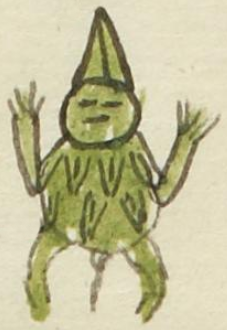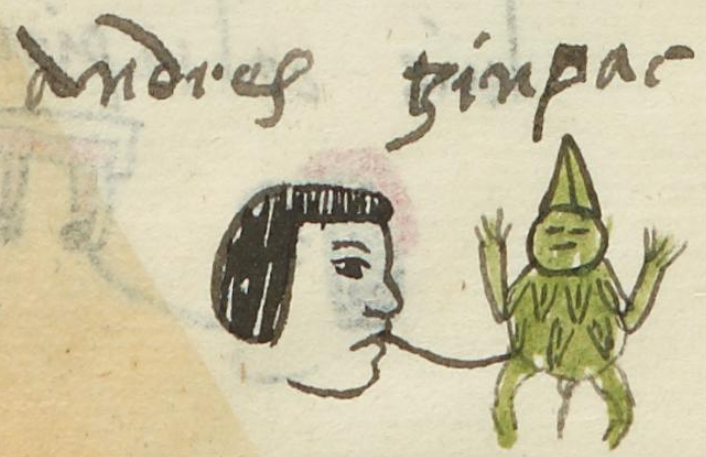Cipac (MH649v)
This colorful painting of the simplex glyph for the personal name Cipac ("Crocodile") shows a bird's eye view of a crocodile with its arms and legs splayed. The pointed protrusions on its back are very much in evidence. A short tail hangs down below the body. A large pointed mouth points upward. An anthropomorphic face also appears, however, on the top of the animal's head. The entire creature is painted green.
Stephanie Wood
This name is a day sign. Originally, a name like this would have a number attached to it. Because of colonial edicts to stop using the tonalpohualli as a source for names, one thing that happened is that the companion numbers were dropped, perhaps as a stopgap measure to reduce the sacred nature of the name. See Norma Angélica Castilla Palma, "Las huellas del oficio y lo sagrado en los nombres nahuas de familias y barrios de Cholula," Dimensión Antropológica v. 65 (sept.-dic. 2015), 186.
The thirteen-day cycle that was started by One-Cipactli was an auspicious time to be born according to a downloadable publication hosted by Mexicolore.
Stephanie Wood
Andres tzinpac
Andrés Cipac
Stephanie Wood
1560
Jeff Haskett-Wood
calendarios, calendars, dates, fechas, días, days, caimanes, cocodrilos, cocodrilo, cipactli, nombres de hombres, tonalpohualli

cipac(tli), crocodile or caiman, https://nahuatl.wired-humanities.org/content/cipactli
Caiman, o Cocodrilo
Stephanie Wood
Matrícula de Huexotzinco, folio 649v, World Digital Library, https://www.loc.gov/resource/gdcwdl.wdl_15282/?sp=381&st=image
This manuscript is hosted by the Library of Congress and the World Digital Library; used here with the Creative Commons, “Attribution-NonCommercial-ShareAlike 3.0 License” (CC-BY-NC-SAq 3.0).









